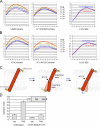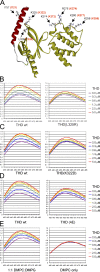Talin activates integrins by altering the topology of the β transmembrane domain
- PMID: 22641344
- PMCID: PMC3365499
- DOI: 10.1083/jcb.201112141
Talin activates integrins by altering the topology of the β transmembrane domain
Abstract
Talin binding to integrin β tails increases ligand binding affinity (activation). Changes in β transmembrane domain (TMD) topology that disrupt α-β TMD interactions are proposed to mediate integrin activation. In this paper, we used membrane-embedded integrin β3 TMDs bearing environmentally sensitive fluorophores at inner or outer membrane water interfaces to monitor talin-induced β3 TMD motion in model membranes. Talin binding to the β3 cytoplasmic domain increased amino acid side chain embedding at the inner and outer borders of the β3 TMD, indicating altered topology of the β3 TMD. Talin's capacity to effect this change depended on its ability to bind to both the integrin β tail and the membrane. Introduction of a flexible hinge at the midpoint of the β3 TMD decoupled the talin-induced change in intracellular TMD topology from the extracellular side and blocked talin-induced activation of integrin αIIbβ3. Thus, we show that talin binding to the integrin β TMD alters the topology of the TMD, resulting in integrin activation.
Figures




References
Publication types
MeSH terms
Substances
Grants and funding
LinkOut - more resources
Full Text Sources
Other Literature Sources
Research Materials

